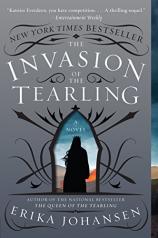Reading Group Guide
Discussion Questions
The Invasion of the Tearling

1. We first encounter the Queen of the Tearling when she visits the Keep’s jail to confront several new prisoners. She is described not as “delicate,” or “pretty,” but “tough,” with hair “short like a man’s.” What does this add to our understanding of her? What role does appearance play in authority?
2. Consider Ewen, the Keep’s Jailor. Despite his intellectual “slowness,” what admirable and valuable qualities does he possess? What of his constant attempt and admitted failure “to paint the things he saw”?
3. Queen Kelsea “had been born angry,” but saw her destructive anger as “pure,” and “the closest she would ever get to the girl she really was deep down.” What might it mean for anger to be “pure”? When does it serve her well or not? In what ways can anger be valuable?
4. What is introduced to the novel with Kelsea’s dreamlike connection to Lily Mayhew and her experience in the time of the pre-Crossing? What’s the effect on the novel of shifting between the two eras and storylines?
5. What qualities do Kelsea and Lily share? In what significant ways are they different? Is this the result of personality or profoundly different times and circumstances?
6. Despite various differences, like the scale and scope of technology, how are the social situations of the pre-Crossing America and that of the Tear similar?
7. What are the attitudes toward and use of books in each society? Why are books and literacy so important to both Kelsea and Lily?
8. How did Lily, an intelligent and independent person, become married to an abusive and dangerous man like Greg? In what ways is this similar to or different from other abused women like Andalie?
9. How does the painful memory of Maddy influence and help Lily?
10. An important theme in the novel is the struggle to balance thoughts of the past and future and how they both affect the present. What’s the relationship between these three conceptions of time? How are they similar or different? What’s a healthy balance of concern for each?
11. Kelsea’s struggle with her own “plain” appearance --- hating herself when seen reflected in a mirror --- continues but is complicated by her gradual transformation into a beautiful woman. What are the origins of her concern with her looks? Why might personal beauty matter to someone with such significant power and responsibility?
12. Consider Andalie and her personal history. What more does her experience reveal about the complex social issues of equality for women, violence against them, autonomy of their own bodies and ability, and even the importance of personal strength? How does her story affect Kelsea? What do Andalie’s daughters, Aisa and Glee, each bring to the novel?
13. Andalie powerfully defines “the crux of evil” as those without empathy, “who feel entitled to whatever they want, whatever they can grab.” What are the origins of such entitlement? In what ways is it the result of “upbringing,” as Kelsea says? How does a system based on inherited royalty avoid encouraging such entitlement? How might such feelings of entitlement be “eradicated”?
14. How does Kelsea’s developing physical desire --- to the point of almost being seduced by the handsome but evil “dark thing” --- complicate her responsibilities as Queen? To what extent are these feelings natural or related to her self-critical thoughts about her “unremarkable” appearance? In what ways is her relationship with close guard and “paramour” Pen Alcott healthy or not?
15. Of what significance, literally and symbolically, is it that Kelsea must forgive and free “the dark thing” in her attempt to defeat the Red Queen? Why is the information she gets so powerful?
16. Despite their differences, Kelsea and the Red Queen both use their powers to harm themselves. Why is this? What relationship does each have to pain? What does self-harm suggest about the complex issues women face regarding beauty, autonomy and their own bodies?
17. Considering the history of the human species, the ebb and flow of enlightenment and goodness, Kelsea wonders if “the most defining characteristic of the species might be lapse.” In what ways might this be true? Why is it so difficult to evolve toward the good despite increased knowledge?
18. The Better World Lily enters is still threatened by people potentially bringing “their own nightmares of the past.” What does this mean? How do people’s personal experiences affect the building of a healthy society?
19. Tear explains to Lily that the Better World will be “doomed to fail” unless people can “put the community’s needs before [their] own.” What are these community needs? What would it take to control or sacrifice one’s personal desires? What forces might be strong enough to enable it?








